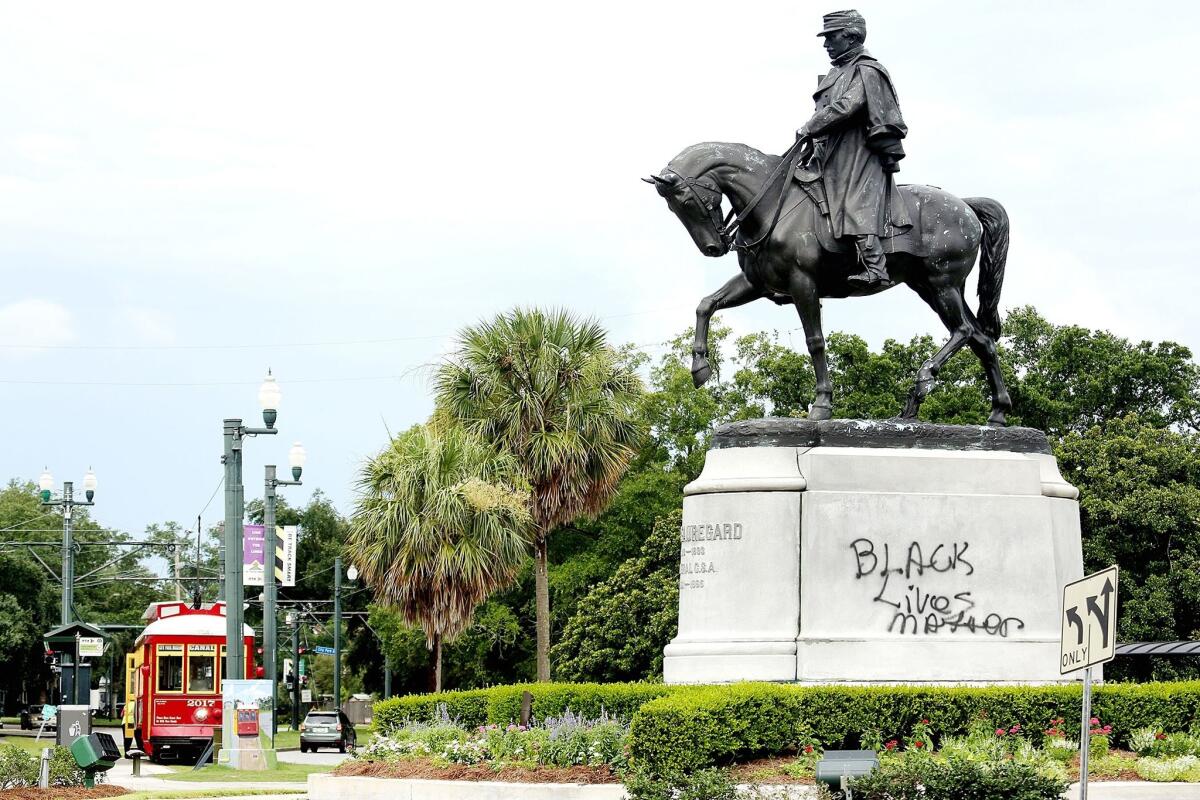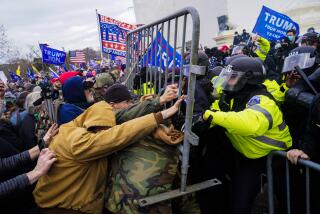Jindal seeks to block removal of Confederate monuments in New Orleans

Two city commissions in New Orleans recommend removing four Confederate monuments, including this statue of Confederate Gen. P.G.T. Beauregard, which was recently marked with paint.
- Share via
A mayoral proposal to remove four Confederate monuments in New Orleans quickly became the latest flashpoint in a national debate over the place of Confederate symbols in the country, as Louisiana Gov. Bobby Jindal announced he would investigate his authority to block their removal.
“Gov. Jindal opposes the tearing down of these historical statues, and he has instructed his staff to look into the Heritage Act to determine the legal authority he has as governor to stop it,” Doug Cain, a Jindal spokesman, said in a statement Friday.
A day earlier, two New Orleans city commissions voted separately to recommend to the City Council the removal of all four monuments.
The four monuments are statues of generals Robert E. Lee and P.G.T. Beauregard, Confederate President Jefferson Davis and a 35-foot-tall obelisk commemorating the Battle of Liberty Place, a three-day rebellion by Confederate veterans against Reconstruction authorities in 1874.
The Thursday votes by the New Orleans Historic District Landmarks Commission and Human Relations Commission were part of a 60-day period of public meetings and discussions before the City Council’s official consideration of the topic. If the council declares the monuments a public nuisance, it will then begin the official process of removal or relocation.
According to the Historic District Landmarks Commission, the recommendation was based on whether the monuments fostered ideologies in conflict with the U.S. Constitution, created a recurring expense and served as a site for violent demonstrations that threatened life or property.
Before the commissions voted, however, dozens of New Orleanians speaking at public hearings voiced their opposition to removing the monuments.
Ashley Merlin, author of “Statuesque New Orleans,” a book of photographs of the city, said that the monuments offered an important lesson in history and art.
“I urge the city to keep the statues where they are currently located,” she said, recommending that the city include interpretive plaques, make the statues part of a walking tour, and erect additional monuments to other national heroes.
Others, who proposed similar ideas, viewed the monuments as a way to educate the public about the role the expansion of slavery played in American history, and said they thought the city of New Orleans itself was a museum.
“To target just these monuments is in some ways quite silly because you’re missing the point,” said Mary Niall Mitchell, a history professor at the University of New Orleans, in an interview. She said the issue should be considered by an independent panel of historians and civil rights leaders in light of the fact that many members of the commissions were appointed by the mayor.
The statues of Lee and Beauregard, which were designed by Alexander Doyle, a prominent sculptor from the era, are listed in the U.S. National Register of Historic Places.
But Judy Reese Morse, New Orleans deputy mayor for citywide initiatives, who spoke at one of Thursday’s hearings, criticized the ideology that had prompted the statues to be erected.
“By relocating these structures, we have the opportunity to change the narrative from the Lost Cause to the story of the new New Orleans, where a diversity of opinions and people can come together and collectively shape what we are and who we are,” she said.
New Orleans Mayor Mitch Landrieu first called on city officials to remove the monuments after the massacre of nine parishioners at a historical black church in Charleston, S.C., in June. Confederate symbols brandished in photos of Dylan Roof, who is charged in the killings, later prompted the removal of the Confederate flag at the South Carolina Statehouse.
Earlier this week, the University of Texas announced that it would move a statue of Jefferson Davis from the center of its campus in Austin, but allow the statues of other Confederate figures, including one of Lee, to remain near the university’s main clock tower.
On Friday, the university said that it would delay plans to move the statue of Davis after the Sons of Confederate Veterans requested a temporary restraining order in a state district court.
Twitter: @natalieschachar
More to Read
Sign up for Essential California
The most important California stories and recommendations in your inbox every morning.
You may occasionally receive promotional content from the Los Angeles Times.










